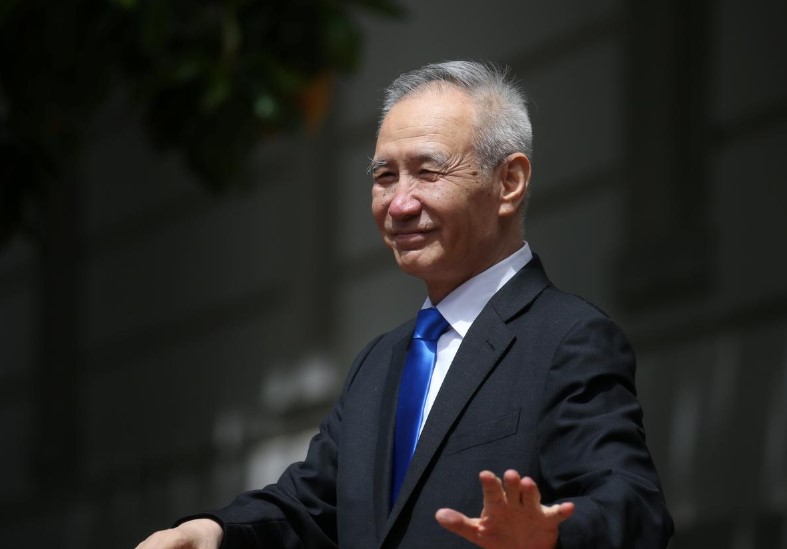
Chinese regulators should step up support for the economy and keep ample liquidity in the financial system, Vice Premier Liu He said on Thursday, suggesting Beijing would soon unveil more policies to bolster growth amid rising U.S. trade pressure.
Beijing has plenty of policy tools and is capable of dealing with various challenges, Liu said at a financial forum in Shanghai.
Despite a slew of support measures and policy easing since last year, China’s cooling economy is still struggling to get back on firm footing, and last month’s sudden escalation in U.S.-Sino tensions has raised fears of a full-blown trade war that could trigger a global recession.
Liu’s comments came a day after data showed China’s credit growth was weaker than expected in May, reinforcing market expectations that more monetary easing is needed. Factory activity contracted in May and imports fell the most in nearly three years, highlighting soft demand.
“At present, we do have some external pressures, but those external pressures will help us boost our self-reliance in innovation and accelerate the pace of high-speed development,” said Liu, who is also the lead negotiator in the U.S.-China trade talks.
The government will roll out more strong measures to promote reforms and opening up, added Liu.
People’s Bank of China chief Yi Gang said last week that there was “tremendous” room to make policy adjustments if the trade war worsens.
Earlier on Thursday, China Daily, citing economists, said China is expected to adjust money and credit supply in coming weeks, including cuts to interest rates or reserve ratio requirements, to counter “downside risks” if trade tensions escalate.
Further cuts in banks’ reserve requirement ratios (RRR) were already expected this year, especially after the trade conflict escalated last month. Both sides hiked tariffs on each other’s goods, and Washington is threatening more.
Last month, the PBOC stepped up efforts to increase loan growth and business activity, announcing a three-phase cut in regional banks’ reserve requirements to reduce financing costs for small and private companies.
It has now cut RRR times six since early 2018, and has also guided short-term interest rates lower.
Unlike previous downturns, however, the central bank has been reluctant to cut benchmark interest rates so far. Analysts believe it has held off on more aggressive measures due to concerns that such a move could risk adding a mountain of debt leftover from past stimulus sprees.
Sources told Reuters in February that the PBOC considered a benchmark rate cut a last resort. But some analysts now think one or more cuts are likely if the trade dispute spirals out of control and the U.S. Federal Reserve starts cutting its rates, giving the PBOC more room to maneuver.
Some analysts believe the chances of a trade deal are receding, with both sides showing signs of digging in. But U.S. President Donald Trump has said he plans to meet his Chinese counterpart Xi Jinping at a G20 summit later this month.
CURRENCY RISKS
More forceful easing could also trigger capital outflows and add pressure on the Chinese yuan.
The yuan has fallen nearly 3 percent since the trade flare-up last month and is nearing the closely watched 7 per dollar mark, a level last seen during the global financial crisis a decade ago.
“China is capable and confident of maintaining stable operation of the foreign exchange market and keep the yuan basically stable at reasonable and balanced levels,” Pan Gongsheng, head of the State Administration of Foreign Exchange, said at the forum.
Citing experts, China Daily said financial institutions were facing tighter liquidity in June, and said authorities want to spur faster credit growth to meet economic growth targets.
Beijing has set a growth target of around 6% to 6.5% for this year, easing from 6.6% in 2018, which was the slowest rate of expansion the country has seen in nearly 30 years.
Analysts at Bank of America Merrill Lynch believe China’s GDP growth could fall to 5.8% this year and 5.6% in 2020 if the trade war intensifies, and expects Beijing to respond with four benchmark rate cuts, more RRR cuts, consumption subsidies and measures to stabilize employment.
On Monday, the government announced steps to give local governments more financing flexibility so they can increase infrastructure spending, a key part of the stimulus plan that has not revived investment as quickly as some China watchers had expected.
The escalating trade war has gone beyond tariffs as the two countries increase pressure on each other to cede ground.
Chinese state media has warned that Beijing could use rare earths for its next strike. The United States relies on China for supplies of the rare earths to make a host of high-tech products.
China is also the biggest holder of U.S. government debt, with about $1.12 trillion in U.S. Treasuries, stirring talk that Beijing could start dumping U.S. bonds.
China is a responsible investor in global financial markets, Pan said.

